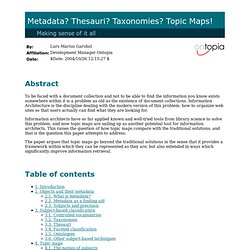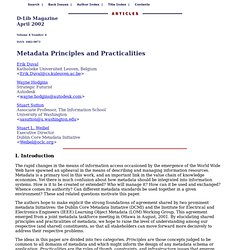

Schema.org - Home. PBCore: Public Broadcasting Metadata Dictionary Project. WorldCat Digital Collection Gateway [OCLC - Digital Collection Services] The WorldCat Digital Collection Gateway provides you with a self-service tool for uploading the metadata of your unique digital content to WorldCat—the premier database of library materials.
![WorldCat Digital Collection Gateway [OCLC - Digital Collection Services]](http://cdn.pearltrees.com/s/pic/th/worldcat-digital-collection-11349419)
Once your metadata is in WorldCat, your collections are more visible and discoverable by end users who search WorldCat as well as Google and other popular Web sites. Ultimately, users will click through to your local servers to access the digital item, viewing it immediately on their screen—anytime, anywhere. Your metadata records retain their local identity while maximizing the global visibility of your digital content. Through the Gateway, as your library, archives, museum or other cultural heritage organization continues to upload metadata, you are developing WorldCat into a premier resource for the integrated discovery of open access, digital primary source materials. Metadata, cataloging, & various librarian-like stuff. How To Use HTML Meta Tags - Search Engine Watch (SEW) Want top search engine rankings?

Just add meta tags and your website will magically rise to the top, right? Wrong. Meta tags are one piece in a large algorithmic puzzle that major search engines look at when deciding which results are relevant to show users who have typed in a search query. While there is still some debate about which meta tags remain useful and important to search engines, meta tags definitely aren't a magic solution to gaining rankings in Google, Bing, Yahoo, or elsewhere – so let's kill that myth right at the outset. However, meta tags help tell search engines and users what your site is about, and when meta tags are implemented incorrectly, the negative impact can be substantial and heartbreaking. Let's look at what meta tags are, what meta tags matter, and how to avoid mistakes when implementing meta tags on your website.
Using Dublin Core. NOTE: This text was last revised in 2005.

As of 2011, a completely revised User Guide is being developed at the wiki page DCMI's Glossary and FAQ are also under revision. Table of Contents 1. Introduction 2. 3. 1. 1.1. Metadata has been with us since the first librarian made a list of the items on a shelf of handwritten scrolls. A metadata record consists of a set of attributes, or elements, necessary to describe the resource in question. The linkage between a metadata record and the resource it describes may take one of two forms: elements may be contained in a record separate from the item, as in the case of the library's catalog record; orthe metadata may be embedded in the resource itself. Examples of embedded metadata that is carried along with the resource itself include the Cataloging In Publication (CIP) data printed on the verso of a book's title page; or the TEI header in an electronic text.
Metadata Thesauri Taxonomies Topic Maps! Making sense of it all Abstract To be faced with a document collection and not to be able to find the information you know exists somewhere within it is a problem as old as the existence of document collections.

Information Architecture is the discipline dealing with the modern version of this problem: how to organize web sites so that users actually can find what they are looking for. Information architects have so far applied known and well-tried tools from library science to solve this problem, and now topic maps are sailing up as another potential tool for information architects. This raises the question of how topic maps compare with the traditional solutions, and that is the question this paper attempts to address. The paper argues that topic maps go beyond the traditional solutions in the sense that it provides a framework within which they can be represented as they are, but also extended in ways which significantly improve information retrieval. Table of contents 1. 2. Metadata Principles and Practicalities.
I.

Introduction The rapid changes in the means of information access occasioned by the emergence of the World Wide Web have spawned an upheaval in the means of describing and managing information resources. Metadata is a primary tool in this work, and an important link in the value chain of knowledge economies. Yet there is much confusion about how metadata should be integrated into information systems. How is it to be created or extended? The authors hope to make explicit the strong foundations of agreement shared by two prominent metadata Initiatives: the Dublin Core Metadata Initiative (DCMI) and the Institute for Electrical and Electronics Engineers (IEEE) Learning Object Metadata (LOM) Working Group.
The ideas in this paper are divided into two categories. II. A. Metadata modularity is a key organizing principle for environments characterized by vastly diverse sources of content, styles of content management, and approaches to resource description. B. C. D.